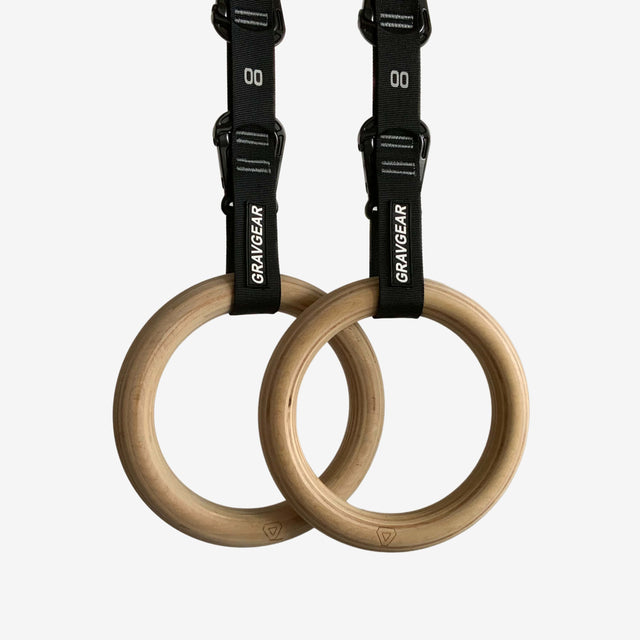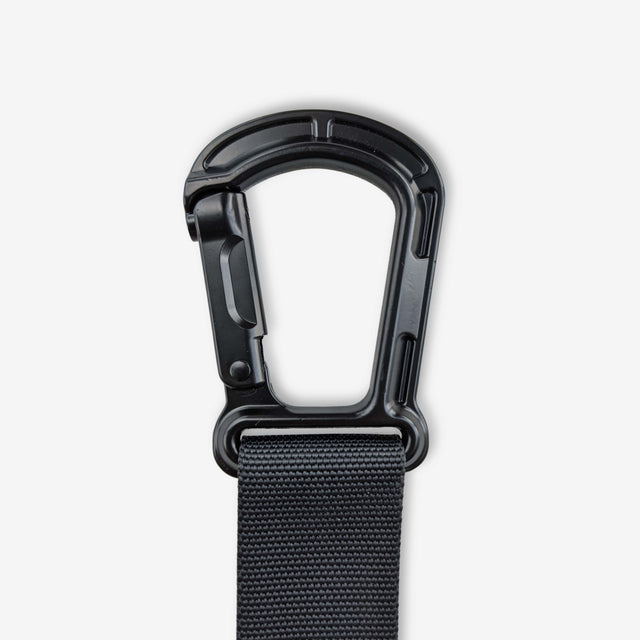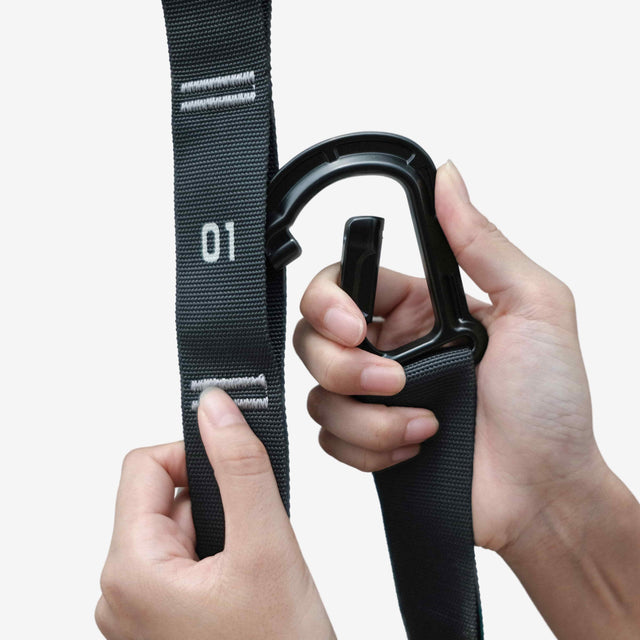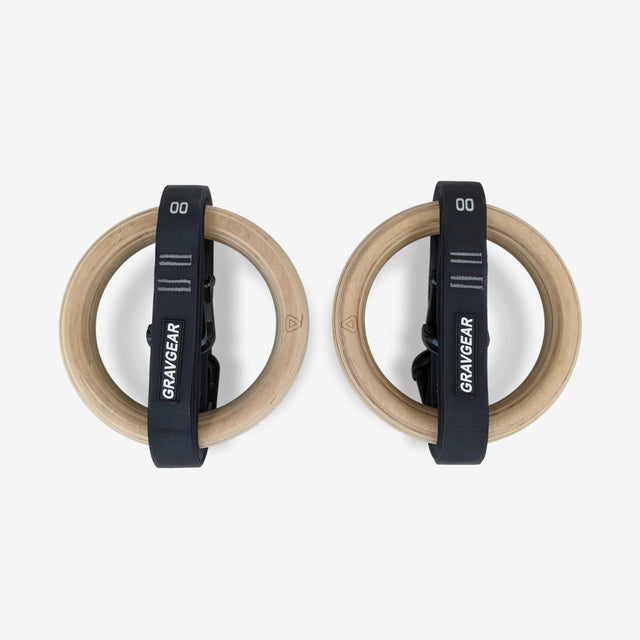5 Gymnastic Rings Physique Examples + How to Get One
In this guide, we’ll show you how to go from a curious beginner to mastering a 4-week plan that’ll give you a rock-solid base in ring training. You’ll see what kind of physique is possible with rings, meet some of the legends who’ve built their bodies on this tool, and get the program to start your own journey.
Jump to:
- Why go for a gymnastic rings physique?
- 5 Gymnastic rings physique examples
- What kind of gymnastic rings physique can 🫵YOU realistically achieve?
- The path to building a gymnastic rings physique
- Example week of a gymnastic rings training program
- 3 Lifestyle checklists to maximize results
- Rings as a portable gym
Ready to give your body something it won’t forget? Let’s get started.
Why go for a gymnastic rings physique?
Look, gymnastic rings aren’t just some gimmick, same with the physique that comes with training on them.
This one piece of kit can build strength, improve balance, and challenge you like nothing else. Rings make you earn your strength; they call out any weakness and force your whole body to work as a team. No stabilizers left behind, no shortcuts.
So why choose rings? Because they go beyond regular weights or machines.
The instability of rings demands control, precision, and a kind of toughness that builds serious, real strength.
You’ll be using muscles you forgot existed, and it’ll take your core to places it’s never been. And rings? They’re not fussy—take them to the park, hang them in your garage, or hook them up to a sturdy tree out in the bush.
They’ll go wherever you do.
What you can expect from ring training
It’s a commitment, but the payoff is huge.
This isn’t about bulking up for the sake of it. With rings, you’re building a physique that’s lean, powerful, functional, and balanced.
You’ll look strong because you are strong—plain and simple.
Here’s what you’ll get if you stick with it:
Muscle definition
Rings sculpt every muscle in your upper body, giving you a defined, natural muscular look
Core power
Every movement on the rings is a core workout. You’ll see it in your abs and feel it in your back, day in, day out.
Endurance & strength
Ring workouts test your endurance and build strength that sticks, giving you power and control you can rely on.
5 Gymnastic rings physique examples
If you want to know what’s possible with gymnastic rings, look no further than the legends who’ve set the bar.
These athletes have built iconic, battle-tested physiques by spending years—decades, even—on the rings.
They’re not just ripped; they’re strong where it counts, with precision, endurance, and the kind of core strength that makes the nearly impossible look easy.
Let’s look at some ring gymnast physique examples who show us what the ultimate level of gymnastic ring achievement really looks like…
1️⃣ - Jury Chechi
Jury Chechi didn’t earn his title, the “Lord of the Rings,” by accident. Known for his phenomenal upper body strength and rock-solid core stability, Chechi is the quintessential example of ring training paying off.
This Italian powerhouse showed up on the Olympic scene with a level of control that most people can’t even imagine, and his gymnastic rings physique tells the story of dedication to strength and resilience. Every fiber of muscle had a purpose.
Chechi’s devotion to gymnastic rings gave him a lean, densely muscled frame with the kind of strength that doesn’t quit, not to mention Olympic gold at the 1996 Atlanta Games.
Chechi’s journey is proof that when you commit to rings, you build more than muscle—you build mastery.
2️⃣ - Chen Yibing
Chen Yibing, one of China’s greats, takes endurance and control to another level.
This guy can hold a still position like a statue, and that kind of stability doesn’t come without insane core strength and upper body conditioning.
His muscle endurance lets him hit positions with accuracy and hold them with zero shake.
He dominated international competitions, collecting titles like the 2008 and 2012 Olympic golds.
Chen’s physique is both aesthetic and functional, with defined lines across his arms, chest, and core that speak to the hours he’s put into perfecting each movement. If there would be a model for a ring gymnast physique magazine, Chen would be one of them.
3️⃣ - Eleftherios Petrounias
Eleftherios Petrounias doesn’t just bring strength to the table—he’s built for it.
With shoulders that look like boulders and a core that’s carved out of stone, Petrounias showcases the muscle mass you can achieve when you push your limits with his “greek god” gymnastic rings physique.
Known for his explosive power and chiseled aesthetic, he’s stacked in a way that looks like he was crafted from granite. This Greek Olympian, a gold medalist at the 2016 Rio Games, shows how powerful and dense your upper body can get with the right training.
Petrounias shows the kind of gymnastic rings physique you can achieve with the muscle mass, sculpted core, and strength in every line of his body.
4️⃣ - Arthur Zanetti
Brazilian athlete Arthur Zanetti has a gymnastic rings physique defined by compact, explosive power. He’s not just about strength; he’s got control and precision on every move.
Zanetti took home gold at the 2012 London Olympics and silver at the 2016 Rio Olympics, and his dedication to rings is etched in the muscle definition across his shoulders, arms, and core.
Zanetti’s aesthetic is proof that ring training gives you strength without sacrificing agility.
He’s not bulky—he’s streamlined, built to move with purpose, and execute power moves that most people wouldn’t dream of attempting.
5️⃣ - Yuri van Gelder
Yuri van Gelder is known for his stability and precision, building a physique that’s all about power and grace.
A veteran of the rings, this Dutch legend has a build that speaks to countless hours of conditioning, with muscle lines that show how strong and lean ring training can make you.
Van Gelder’s focus on stability training allowed him to develop a level of body control that turns muscle into art.
With titles like the 2005 World Championship in the rings event, Van Gelder’s gymnastic rings physique shows us that ring training gives you more than strength; it gives you mastery over every inch of your body.
What kind of gymnastic rings physique can 🫵YOU realistically achieve?
Here’s the truth: ring training doesn’t just build muscle—it builds a bod’ that’s as strong as it looks. Smaller deep stabilizer muscles are worked very heavily, which means it takes longer than weightlifting in terms of building mass.
The aesthetic
A gymnastic rings physique is a lean, athletic look that’s packed with real, functional strength. So expect to see more definition and practical strength than a pure bodybuilder's mass which tends to have less “definition” and more “bulk”.
Rings give you a different kind of muscle tone. Instead of big isolated muscles, ring training sculpts a body that’s lean, toned, and balanced. This isn’t just about big arms or a wide chest; it’s about full-body muscle tone, with a core that looks as solid as it feels.
With rings, you’re training every angle, activating those stabilizer muscles and creating muscle definition that’s unique to calisthenics.
Think of it as a kind of athletic muscle—strong and practical, built to handle real-world movement.
3 Gymnastic rings physique benefits beyond aesthetics
1) Core strength & stability
Every move on the rings works your core. You’ll feel it in your abs, obliques, and lower back, which is why you see many a gymnastic rings physique with rock-solid, cut cores.
The constant stability work gives you a core that’s not just ripped but functionally strong.
2) Enhanced joint & tendon health
Rings also challenge and strengthen your joints and tendons. Because of the instability, your body’s constantly making micro-adjustments, which strengthens those connective tissues in ways that weights don’t.
This can lead to better flexibility, improved joint health, and a reduced chance of injury over time.
3) Functional strength for real life
With rings, you’re not just lifting weight up and down. Every move demands coordination, balance, and control, creating functional strength that carries over to real-life movements.
You’re building a gymnastic rings physique that’s capable—not just in the gym, but in daily life too.
Realistic gymnastic rings physique results timeline
Alright, so what can you actually expect over time? Ring training isn’t instant, but the results stick around.
1-3 months
In the first few months, you’ll see gains in stability, coordination, and basic strength.
Expect to master foundational moves like holds and controlled push-ups.
You may not look shredded just yet, but your core will feel stronger, and you’ll notice better posture and balance.
3-6 months
By now, you’ll see visible muscle tone—arms, shoulders, chest, and core.
You’ll be handling intermediate exercises, like ring dips and pull-ups, with a bit more confidence.
It’s a turning point where you start looking like you’ve been putting in work.
6-12 months
In six to twelve months, you’ll see noticeable muscle definition and stability.
Expect to start progressing toward advanced holds and complex exercises that demand serious control.
The payoff is a balanced gymnastic rings physique with visible muscle and strength that’s functional.
The path to building a gymnastic rings physique
Training with rings is about building strength, yes, but also balance, endurance, and, most importantly, control. You can’t fake it on rings—they force you to use every muscle and stabilize like a pro.
Here’s how to build your own gymnastic rings physique, step by step.
Core elements of ring training
💪 Strength
Rings aren’t kind to shortcuts. You’re not just lifting weight here; you’re stabilizing, controlling, and balancing yourself every single rep.
So, start simple and focus on strength before moving to flashier moves.
Foundational exercises:
- Ring rows
- Dips
- Push-ups on the rings
They’re not fancy, but they’ll get your muscles working. Nail the form now because as you progress, any wobble or weakness will be a roadblock.
Progress to advanced moves:
- Ring pull-ups
- Muscle-ups
These moves demand more than strength—they’ll test your control and technique, which is the hallmark of a gymnastic rings physique.
🤹♂️ Stability & balance
Rings are naturally unstable, so every move challenges your balance, making you control every muscle in your body. That instability builds strength in places machines and free weights can’t touch. Your joints (wrists, shoulders, elbows) and core will get an intense workout just keeping you steady.
Core & joint stability moves:
- Support holds
- Ring planks
Unlike fixed equipment, rings call out your body’s weak spots. Everything from your legs to your shoulders comes into play for balance.
Over time, you’ll notice better overall strength, especially in those stabilizer muscles.
🎮 Endurance & control
Strength’s great, but if you want to hold a position or execute a move like the pros, you’ll need control. Ring training demands patience, slow progression, and an ability to hold your own.
Start with manageable holds—think short tuck holds or basic support positions. Gradually add seconds as you get stronger.
Control in these positions is what gives gymnasts that sculpted, rock-solid look.
After building up your reps, introduce static holds. These aren’t just for show—they’re brutal on your muscles, teaching your body to endure and stay stable under tension.
Adapting to your level
Whether you’re brand new or seasoned with bodyweight training, there’s always a way to get started with rings.
👶 Beginners
Beginners, it’s all about mastering the basics. You’re not going for “Instagram-worthy” moves; you’re going for strength and control.
Exercises to Start With:
- Support holds
- Knee tucks
- Ring rows
These are basic but effective, teaching you balance and control while building a foundation.
Focus on form, and don’t rush. Every movement needs to be controlled and precise. Rings won’t let you cheat, so use this stage to lock down your form.
👦 Intermediate
You’ve got the basics down, and now it’s time to up the challenge. This stage is all about pushing further while maintaining control.
Intermediate moves:
- Ring dips
- Elevated push-ups
- Knee raises
Slow down your tempo or increase reps for a tougher workout.
You also want to start working on holds and transitions, like moving from a support hold to a tuck. It’ll push your endurance and improve your strength, taking you one step closer to advanced moves.
👨 Advanced
These are the ones you see gymnasts pulling off that make jaws drop.
Advanced exercises:
- Muscle-ups
- Front levers
- Iron cross
They’re challenging, but with control and strength built in previous stages, you’re ready to give them a shot.
Aim for longer holds with each session—this is where you test your stability, strength, and control. Moves like the front lever or L-sit will make your core and shoulders work overtime, adding that last bit of polish to your gymnastic rings physique.
Training frequency & recovery
Rings put a heavy load on your body, so knowing when to go hard and when to rest is crucial.
🔁 Frequency
Stick with 3-5 days per week. Beginners should aim for three days with active recovery in between, while more advanced trainers can add a couple of extra days as they adapt.
🛌 Recovery practices
Your muscles need time to recover, so prioritize sleep, use foam rolling, and consider light cardio on off days. You’ll feel stronger and recover faster.
🤕 Avoiding overuse injuries
Rings can strain your joints and tendons if you push too hard too soon. So ease up when your body signals a need for rest, and focus on flexibility and stabilization exercises to avoid injury.
And that’s the roadmap!
Stick with it, and you’ll be building a body that doesn’t just look strong but is solid where it counts. You’re on your way to a true gymnastic rings physique—hard-earned, practical, and built to last.
Example week of a gymnastic rings training program
But first, know this context when reading the table:
- X / Y / Z formatted points means Beginner / Intermediate / Advanced. So 40-60s time under tension is for beginners, and 60-80s time under tension is for advanced. As an example.
- Control each rep. Lower down for 4 seconds, hold for 1 second at the bottom, lift up for 2 seconds, and no pause at the top.
- If you reach the top rep count (12) easily, progress to a harder variation or add weight.
- Adjust rest time by level. This keeps intensity high while allowing for proper recovery based on experience.
| Day | Workout focus | Exercise | Sets | Reps / Time under tension | Tempo | Rest |
| Day 1 | Push | Push-ups on rings | 3 / 4 / 5 | 8-12 | 4-1-2-0 | 60s / 50s / 40s |
| Ring dips | 3 / 4 / 5 | 8-12 | 4-1-2-0 | 60s / 50s / 40s | ||
| L-sit hold | 3 | 40-60s / 50-70s / 60-80s | - | 60s / 50s / 40s | ||
| Day 2 | Pull | Ring rows | 3 / 4 / 5 | 8-12 | 4-1-2-0 | 60s / 50s / 40s |
| Pull-ups on rings | 3 / 4 / 5 | 8-12 | 4-1-2-0 | 60s / 50s / 40s | ||
| Hollow hold | 3 | 40-60s / 50-70s / 60-80s | - | 60s / 50s / 40s | ||
| Day 3 | Rest/Active Recovery | - | - | - | - | - |
| Day 4 | Full Body | Ring flyes | 3 / 4 / 5 | 8-12 | 4-1-2-0 | 60s / 50s / 40s |
| Pike push-ups | 3 / 4 / 5 | 8-12 | 4-1-2-0 | 60s / 50s / 40s | ||
| Hollow hold | 3 | 40-60s / 50-70s / 60-80s | - | 60s / 50s / 40s | ||
| Day 5 | Strength Challenge | Single-arm rows | 3 / 4 / 5 | 8-12 per side | 4-1-2-0 | 60s / 50s / 40s |
| Tuck planche hold | 3 | 40-60s / 50-70s / 60-80s | - | 60s / 50s / 40s | ||
| Leg raises | 3 | 8-12 | 4-1-2-0 | 60s / 50s / 40s | ||
| Day 6 | Core | L-sit hold | 3 | 40-60s / 50-70s / 60-80s | - | 60s / 50s / 40s |
| Plank hold | 3 | 40-60s / 50-70s / 60-80s | - | 60s / 50s / 40s | ||
| Russian twists | 3 | 8-12 per side | - | 60s / 50s / 40s | ||
| Day 7 | Rest/Flexibility | - | - | - | - | - |
3 Lifestyle checklists to maximize results
Getting a gymnastic rings physique goes beyond just the workouts. How you fuel up, how you recover, and how you prevent injuries all play a big part.
Here’s how to keep every element dialed in for maximum gains…
#1 → Nutrition
Your muscles aren’t growing without the right food. Think of it this way: what you eat becomes your strength. So, let’s keep it simple and effective.
✅ Lean proteins
Key for muscle repair and growth. Focus on sources like chicken, fish, eggs, tofu, and legumes. Aim for 1.6-2.2 grams per kilogram of body weight each day.
✅ Healthy fats
These aren’t just energy—they’re crucial for joint health. Avocado, olive oil, nuts, and fatty fish are your best mates here.
✅ Complex carbs
Your main fuel for training sessions. Stick to whole grains, oats, quinoa, and sweet potatoes. They also help with recovery by restoring muscle glycogen.
Adjusting intake based on goals:
- Bulking: Add a 10-15% calorie surplus to build muscle. Keep it clean with quality sources.
- Cutting: Stick to a slight calorie deficit but keep protein high to maintain muscle.
| Quick definitions |
| "Calorie surplus" is eating more calories than you burn to support muscle growth. "Calorie deficit" means eating less to promote fat loss while maintaining muscle. |
#2 → Recovery & sleep
Muscle isn’t built in the gym—it’s built in recovery. Don’t skip this part if you want to see results.
✅ Sleep
Aim for 7-9 hours a night. This is when your body repairs and grows, plus it regulates important hormones for muscle building.
✅ Active recovery
Light activities like walking, stretching, or foam rolling on rest days can help flush out lactic acid and reduce stiffness.
✅ Hydration
Staying hydrated keeps muscles and joints working smoothly and cuts down on soreness.
#3 → Injury prevention
Rings train your joints and stabilizers hard, so let’s keep them safe. Injuries can set you back fast, so here’s how to avoid them.
✅ Warm up properly
Spend at least 1-3 minutes warming up, especially focusing on shoulders, wrists, and core. Think dynamic stretches, arm circles, and light joint movements.
Your first set can even count as your warm up, if you’re not going straight into highly intense gymnastic ring moves right off the bat.
✅ Perfect form over reps
Rings expose weak points fast. Stick with good form, even if that means fewer reps. If it’s too easy, make it harder; if it’s too hard, scale back.
Reps don’t matter as much as intensity and time under tension matter when it comes to strength and muscle development.
You could do 10 quick reps and kinda feel achy after. Or you could do 10 clean and controlled tempo reps, then really know you’ve challenged yourself and gotten stronger.
✅ Respect rest days
Overuse injuries sneak up on you. Use rest days to let your muscles and joints recover fully.
| Keep in mind |
| "Overuse injuries" happen when you repeatedly stress the same muscles or joints without enough rest, leading to pain and inflammation. |
When you train hard, eat well, and rest right, you’re setting yourself up for real, lasting results. Rings demand consistency, so make these lifestyle changes a priority to get the most out of every session.
Rings as a portable gym
When it comes to convenience, gymnastic rings have it in the bag. They’re light, easy to pack, and don’t need fancy equipment to set up.
They’re the ultimate portable gym, and if you’re someone who wants to stay strong on the go, rings are the answer.
Benefits of a portable setup
Rings are a dream for portability. They fit easily into a backpack, weigh next to nothing, and are dead simple to set up.
Unlike bulky gym gear, rings let you train anywhere with enough space—be it at home, the local park, or even a seaside docks.
You can target strength, balance, and stability without having to rely on a fixed location, and they’re perfect for a solid workout wherever you are.
Adaptability for travel & outdoor workouts
One of the best parts about rings is their versatility in setup. You’ve got loads of options: toss them over a sturdy tree branch, set them up on a door frame, or clip them onto a pull-up bar.
This adaptability means you’re not limited to indoor workouts; you can train out in the fresh air or find a spot in the park to get in a full-body session.
Plus, when you’re on the road, having a go-to setup option lets you keep up with your fitness routine without skipping a beat.
4 Tips for ring setup
Getting your rings set up right is key. Here are a few quick tips to make sure you’re maximizing your workout:
1️⃣ Height adjustment
Start by setting the rings around hip height for push-ups, dips, and rows. Lower them for core exercises and certain holds.
2️⃣ Spacing
Aim for a distance that matches the width of your shoulders. Too wide or too narrow, and you’ll compromise both comfort and stability.
3️⃣ Outdoor setup
If you’re setting up on a tree or similar anchor, double-check stability and use a branch or beam that can hold your weight with zero risk of snapping.
4️⃣ Adjustment & safety
Make sure the straps are fully secure and the buckles are locked in tight. Always give it a test pull before putting full weight on them.
Bottom line
You will achieve a fantastic gymnastic rings physique using this guide, and the right high-quality pair of rings.
If you found it genuinely helpful, then feel free to:
- Drop a comment below giving any feedback on this blog, sharing ideas, or showing others what’s possible
- Join our Gravgear telegram channel with over 3k+ members so you can share your progress
- Link this blog to your calisthenics comrades so they get on this challenge too!










0 Comments
There are no comments for this article. Be the first one to leave a message!